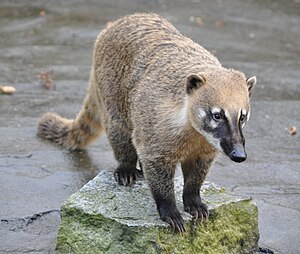South American coati
| South American coati | ||||||||||||
|---|---|---|---|---|---|---|---|---|---|---|---|---|

South American coati ( Nasua nasua ) |
||||||||||||
| Systematics | ||||||||||||
|
||||||||||||
| Scientific name | ||||||||||||
| Nasua nasua | ||||||||||||
| ( Linnaeus , 1766) |
The South American coati ( Nasua nasua ) is a species of predator belonging to the small bear family (Procyonidae).

description

The fur color of the South American coatis varies from reddish brown to gray, the underside is lighter, almost whitish. The short, strong feet are colored black, the tail is conspicuously curled. The elongated head is characterized by the elongated snout, which is very mobile and serves to search for food in the ground. White drawings can be seen along the snout, but these are less pronounced than in the white-nosed coati . The ears are short and rounded. South American coatis reach a head body length of 41 to 67 centimeters, a tail length of 32 to 69 centimeters and a weight of 3.5 to 6 kilograms.
Distribution area and habitat
These animals live in almost all of South America , from Colombia , French Guiana and Venezuela to Uruguay and northern Argentina . Their habitat are forests of all kinds, from tropical rainforests to river forests to mountain forests at 2500 meters above sea level.
The South American coati was added to the “List of Unwanted Species” for the European Union in 2016.
Way of life
South American coatis are primarily diurnal. The foraging for food takes place mainly on the ground, for sleeping, for mating and for the birth of the young they climb trees, they can also swim very well. When moving on the ground, the tail is stretched vertically upwards, when climbing it is used for balance.
Females and juveniles live in groups of four to 20 animals, while males are solitary animals. Male animals are territorial animals that vehemently defend their territories against their peers. The groups of females and young animals show less pronounced territorial behavior.
food
South American coatis are omnivores that feed on both vegetable foods such as fruits and animal foods such as insects and their larvae, spiders, scorpions, small vertebrates and carrion.
Reproduction
At breeding time, a group allows a male to approach. This subordinates itself to the females through grooming and other submissive behavior, after which it mates with all animals and is then driven away again.
After a gestation period of around 74 to 77 days, the female gives birth to three to seven young animals. At birth it retreats into a leaf nest in the trees, around five to six weeks later it rejoins the group with the young. They are weaned at four months and reach sexual maturity at around two years of age. The highest known age of an animal in human care was over 17 years.
threat
The natural predators of the South American coatis include birds of prey , giant snakes and cats such as pumas , jaguars and jaguarundis . They are hunted by humans because they sometimes loot chicken coops and wreak havoc in pantries. They are widespread and are not endangered species.
Web links
- Nasua nasua in the endangered Red List species the IUCN 2006. Posted by: Mustelid Specialist Group, 1996. Retrieved on 12 May, 2006.
Individual evidence
- ↑ Implementing Regulation (EU) 2016/1141 of the Commission of July 13, 2016 on the adoption of a list of invasive alien species of Union-wide importance (PDF) Official Journal of the European Union, L 189/4 of July 14, 2016 (German version).

